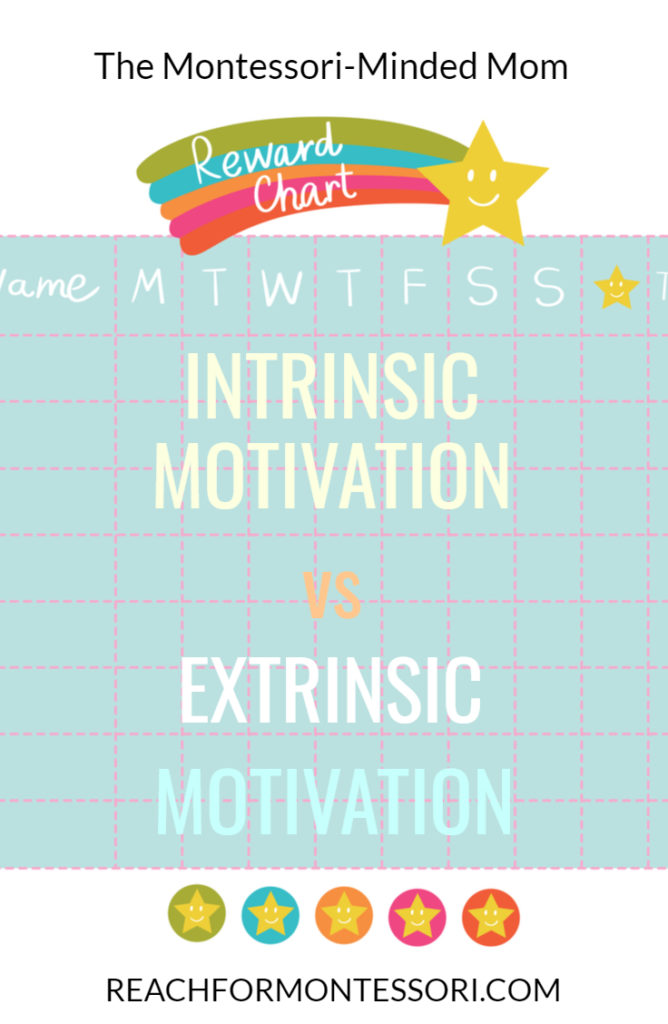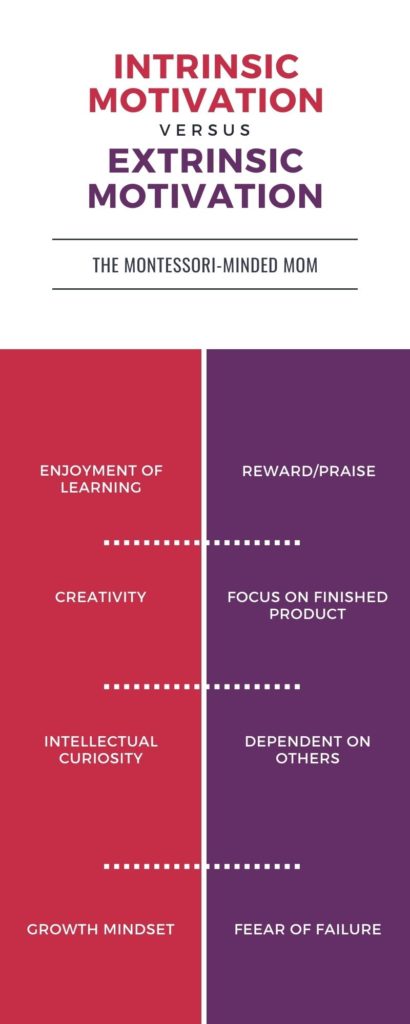In this article, we're going to be comparing intrinsic motivation to extrinsic motivation. We'll find out a bit about what each one is and discover which is the better type of motivation.
Children (and adults!) learn new things every day. Learning is part of living, and it’s just as natural.
Unfortunately, some traditional methods of early childhood education make learning harder and more complicated than it has to be.
One of the biggest missteps of these conventional educational models can be found in the use of extrinsic rather than intrinsic motivators.

As a parent and educator, you’ve probably heard of the two basic types of motivation—intrinsic and extrinsic—but you may be wondering how they play into a Montessori approach to teaching and learning.
Montessori and motivation are actually tightly intertwined. You could even say that motivation lies at the heart of the Montessori pedagogy.
Let’s discuss why motivation is so important to learning and dig into the two distinct types of motivation.
Why Is motivation so important to learning?
When you think about education and learning, what are some things that come to mind?
For many parents and teachers today, factors like intelligence, instructional strategies, and educational materials are immediately identified.
These are all important aspects of the learning process.
Another important element that often goes unrecognized is the idea of motivation. It’s a crucial concept, though, and one that shouldn’t be ignored by anyone concerned with early learning.
I’d even go so far as to say that without motivation, very little learning can take place.
You Can Lead a Horse to Water, But…
Remember the old adage, “You can lead a horse to water, but you can’t make it drink.”
The proverb has important implications for Montessori learning (and, well, learning in general).
The idea here is that since motivation comes from within, you can’t really make anyone do anything, whether it be learning or in this case, drinking.
If we apply the metaphor to the learning environment, we can draw the conclusion that learning only takes place if the child wants it to, that is—if they have the motivation to learn.
As teachers and parents, there are certainly things we can do to make the environment ripe for learning.
We can provide sensory learning materials, for instance, and we can set the child up for success by offering age and skill-appropriate activities.
At the end of the day, however, authentic learning will take place only if motivation is present.

Where does motivation come from?
Since motivation is so central to the learning process, it’s important to understand where it comes from exactly.
This brings us to the topic at hand—intrinsic versus extrinsic motivation. Intrinsic motivation is motivation that comes from within, while extrinsic motivation comes from an external source.
By simply reading those basic definitions, you likely already have the sense that intrinsic motivation is the more powerful of the two.
That’s because you already know deep down that things that come from within are authentic, natural, and meaningful.
If without reading any further, you were to guess that intrinsic motivation is the more preferable of the two types of motivation, you’d be right.
That doesn’t mean that extrinsic motivation never works. In fact, children in classrooms across the world are mastering learning goals in exchange for stickers, candy, and pizza parties.
You likely had some of these same experiences as a youngster yourself. If external motivation has worked to encourage learning for decades, then why question it?
This leads us to the fundamental problem with extrinsic motivation.
Why intrinsic motivation trumps extrinsic
The truth is that extrinsic motivation is a poor substitute for the innate motivation that already exists within each one of us. And like most stand-ins, it can do more harm than good.
Studies in educational psychology have shown that extrinsic motivators such as rewards for mastery actually undermine intrinsic motivation.
That means that when parents and teachers offer incentives for learning, we’re actually taking away from the innate joy of learning for learning’s sake.
Sad, isn’t it?
That’s not to say that these efforts are malicious in any way.
To the contrary, most parents and teachers who rely on extrinsic motivators for guiding their little ones have the very best intentions at heart.
Even so, they may be hampering learning for the children in their care. Fortunately, when we know better, we do better.
Let’s do better!

Montessori and intrinsic motivation
In Montessori learning environments, extrinsic motivators such as stickers and even verbal praise are passed over in favor of strategies that help facilitate a child’s innate motivation to learn.
Some of the most powerful ways to encourage a child intrinsically include allowing them to choose their own learning materials and providing them with ample time and space to engage in meaningful learning.
The Montessori teacher can also exhibit his or her own passion for learning and model intrinsic motivation for students.
The goal here is to create an environment where learning is valued and celebrated in its own right.
In environments where children are immersed in their own preferred learning experiences, offering them a gold star would be nothing more than a distraction. Montessori children acknowledge learning as its own reward.
The problem with effort
This is where it gets a little sticky..
In mainstream learning environments, parents and teachers tend to emphasize the need for effort. This is particularly true as children get older.
The belief is that learning will occur when effort is present, and with this belief comes the push to increase students’ effort, usually through extrinsic motivators.
While there may be some truth to the theory that effort and learning are related, it misses the mark by a mile. The most important ingredient to meaningful learning is not effort, but motivation.
When children experience high levels of motivation, learning becomes essentially effortless.
When it comes to your child’s learning, just remember this short mantra: Don’t force it; embrace it.
As with most things Montessori, embracing intrinsic over extrinsic motivation requires a simple mindset tweak.
Once you understand the power of intrinsic motivation and see its effects for yourself, you’ll be hooked, and your child will be all the better for it!
Cheers and don't forget to subscribe!

You’re making some great points. Really got me thinking about my approach. Thank you!